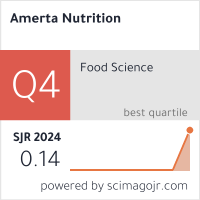Development of Under-five Wasting Children and Related Factors in Padang City
Perkembangan dan Faktor yang Berhubungan dengan Balita Wasting di Kota Padang

Background: At the age of under five years, there is rapid physical, cognitive, social, and emotional development, which influences their future abilities. The prevalence of wasting in Indonesia is 7.7%, but it has not received serious attention, so it needs to be explored further.
Objectives: This Study aimed to examine the development of under-five wasting children and any associated factors in the Anak Air's Health Center Working Area, Padang City.
Methods: It was observational analytical research with a cross-sectional design. The research sample was under-five wasting children aged 12 – 60 months, totaling 118 people taken as respondents. Data on the internal factors of respondents was collected using a validated questionnaire. The development of respondents was examined by using the pre-developmental screening questionnaire. Data was analyzed using chi-square and ordinal logistic regression.
Result: This study found that most respondents were under 3 years old, male, had normal birth weight, and had no history of suffering from infectious diseases. A total of 13 (11.1%) of respondents had deviation development, 59 (50%) were doubtful, and only 46 (38.9%) had normal development. Bivariate results showed a significant relationship between age, gender, and infectious diseases with respondents' development (p-value<0.5). There is no significant relationship between birth weight and the respondents’ development (p-value>0.5). Age is the most related factor to the respondents’ development.
Conclusion: The conclusion is most respondents have questionable and distorted development, and age is the most related factor. More attention is needed for under-five wasting children so that their development is normal.
UNICEF, W. a. W. B. G. Levels and Trends in Child Malnutrition. New York. (2023). URL: https://www.who.int/publications/i/item/9789240073791.
Kementerian Kesehatan RI (2022a). Buku Saku Hasil Studi Status Gizi Indonesia (SSGI) Tahun 2022. (2022). URL: https://repository.badankebijakan.kemkes.go.id/id/eprint/4855/3/Buku%20Saku%20SSGI%202022%20rev%20270123%20OK.pdf.
Kementerian Kesehatan RI. Pedoman Indikator Program Kesehatan Masyarakat Dalam RPJMN Dan Renstra Kementerian Kesehatan Tahun 2020 - 2024. Jakarta (2020).
Husin, M., Wikananda, G. & Suryawan, I. W. B. The association between wasting nutritional status and delayed of child development in children age 12-60 months in Wangaya General Hospital, Denpasar, Bali. Intisari Sains Medis 10 (2019). DOI: https://doi.org/10.15562/ism.v10i2.384.
Richard, S. A. et al. Wasting is associated with stunting in early childhood. The Journal of nutrition 142, 1291-1296 (2012). DOI: https://doi.org/10.3945/jn.111.154922.
Schoenbuchner, S. M. et al. The relationship between wasting and stunting: a retrospective cohort analysis of longitudinal data in Gambian children from 1976 to 2016. The American journal of clinical nutrition 110, 498-507 (2019). DOI: https://doi.org/10.1093/ajcn/nqy326.
Diana, F. M. Pemantauan perkembangan anak balita. Jurnal Kesehatan Masyarakat Andalas 4, 116-129 (2010). DOI: https://doi.org/10.24893/jkma.v4i2.79.
Arisman 2008, Gizi dalam Daur Kehidupan, Jakarta: Penerbit Buku Kedokteran. EGC.
Andini, V., Maryanto, S. & Mulyasari, I. The correlation between birth length, birth weight and exclusive breastfeeding with the incidence of stunting in children age group 7-24 months in wonorejo village, pringapus district, semarang regency. Jurnal Gizi Dan Kesehatan 12, 49-58 (2020). DOI: https://doi.org/10.35473/jgk.v12i27.60.
Hatch, B., Healey, D. M. & Halperin, J. M. Associations between birth weight and attention‐deficit/hyperactivity disorder symptom severity: indirect effects via primary neuropsychological functions. Journal of Child Psychology and Psychiatry 55, 384-392 (2014). ). DOI: 10.1111/jcpp.12168.
Andreanetta, P. T., Santosa, Q., Indriani, V., Arifah, K. & Fatchurohmah, W. Hubungan Berat Badan Lahir Dengan Status Gizi Dan Perkembangan Anak Usia 6-60 Bulan. Jurnal Medika Udayana 11, 7-11 (2022). DOI: 10.24843.MU.2022.V11.i9.P07.
Febri, T. S. Faktor-Faktor yang Berhubungan dengan Perkembangan Balita Wasting i Wilayah Kerja Puskesmas Anak Air Kota Padang Tahun 2023, Universitas Andalas, (2024).
Dhamayanti, M. Kuesioner praskrining perkembangan (KPSP) anak. Sari Pediatri 8, 9-15 (2016). DOI: http://dx.doi.org/10.14238/sp8.1.2006.9-15.
Erika, E., Sari, Y. & Hajrah, W. O. Kejadian Wasting pada Balita Usia 6-59 Bulan: Wasting Incidence among Toddlers aged 6-59 Months. Jurnal Bidan Cerdas 2, 154-162 (2020). DOI: https://doi.org/10.33860/jbc.v2i3.110.
Soedarsono, A. M. & Sumarmi, S. Faktor yang Mempengaruhi Kejadian Wasting pada Balita Di Wilayah Kerja Puskesmas Simomulyo Surabaya Factors that Influence the Incident of Wasting Among Children Under Five Years Old In Simomulyo Public Health Center Surabaya. (2021). DOI: https://doi.org/10.20473/mgk.v10i2.2021.237-245.
Afrah, R., Desmawati, D. & Sriyanti, R. Tackling Toddler Malnutrition: Exploring Maternal Influences on Wasting. DOI: https://doi.org/10.52403/ijrr.20240105.
Black, R. E. et al. Maternal and child undernutrition and overweight in low-income and middle-income countries. The lancet 382, 427-451 (2013). DOI: 10.1016/S0140-6736(13)60937-X.
Shatla, M. M. & Goweda, R. A. Prevalence and factors associated with developmental delays among preschool children in Saudi Arabia. Journal of High Institute of Public Health 50, 10-17 (2020). DOI: 10.21608/jhiph.2020.79318.
Gupta, S., Shrivastava, P., Samsuzzaman, M., Banerjee, N. & Das, D. K. Developmental delay among children under two years of age in slums of Burdwan Municipality: A cross-sectional study. Journal of Family Medicine and Primary Care 10, 1945-1949 (2021). DOI: 10.4103/jfmpc.jfmpc_1926_20.
Hanna, H. Faktor-Faktor yang Berpengaruh Terhadap Gangguan Tumbuh Kembang Pada Anak di Klinik Tumbuh Kembang Rsia Bunda Aliyah. Jurnal Mahasiswa BK An-Nur: Berbeda, Bermakna, Mulia 8, 252-263 (2022). DOI: http://dx.doi.org/10.31602/jmbkan.v8i3.9023.
Pratama, A. A., Ardian, J., Lastyana, W. & Rahmiati, B. F. Hubungan Status Gizi dengan Perkembangan Anak Usia 1-5 Tahun. Nutriology: Jurnal Pangan, Gizi, Kesehatan 4, 33-38 (2023). DOI: https://doi.org/10.30812/nutriology.v4i2.3239.
Arifuddin, D., Nulanda, M., Jafar, M. A. & Abdullah, R. P. I. Hubungan Status Gizi Dan Riwayat BBLR Terhadap Perkembangan Anak Dengan Studi KPSP Dipuskesmas Maradekaya. Fakumi Medical Journal: Jurnal Mahasiswa Kedokteran 3, 308-318 (2023). DOI: https://doi.org/10.33096/fmj.v3i4.198.
Zhang, J. et al. Factors influencing developmental delay among young children in poor rural China: a latent variable approach. BMJ open 8, e021628 (2018). DOI: 10.1136/bmjopen-2018-021628.
Amir, N. A. R., Budihastuti, U. R. & Murti, B. Factors Associated with Development in Children Under Five. Journal of Maternal and Child Health 4, 40-48 (2019). DOI: https://doi.org/10.26911/thejmch.2019.04.01.06.
Nazi, S. & Aliabadi, F. Comparison of motor development of low birth weight (LBW) infants with and without using mechanical ventilation and normal birth weight infants. Medical journal of the Islamic Republic of Iran 29, 301 (2015). URL: https://pmc.ncbi.nlm.nih.gov/articles/PMC4764289/pdf/MJIRI-29-301.pdf.
Nengsih, U. & Noviyanti, D. S. D. Hubungan riwayat kelahiran berat bayi lahir rendah dengan pertumbuhan anak usia balita. Jurnal Bidan 2, 234046 (2015). URL: https://media.neliti.com/media/publications/234046-hubungan-riwayat-kelahiran-berat-bayi-la-3abc33e7.pdf.
Hayuningtyas, R. D., Laila, S. F. N. & Nurwijayanti, N. Analysis of Factors Affecting the Development of Children of Toddler Ages Assessed from History of Infection Diseases, Nutritional Status and Psychosocial Stimulation in Ponorogo Regency. Journal for Quality in Public Health 3, 341-347 (2020). DOI: https://doi.org/10.30994/jqph.v3i2.82.
Desyanti, C. & Nindya, T. S. Hubungan riwayat penyakit diare dan praktik higiene dengan kejadian stunting pada balita usia 24-59 bulan di wilayah kerja Puskesmas Simolawang, Surabaya. Amerta Nutrition 1, 243-251 (2017). DOI: https://doi.org/10.20473/amnt.v1i3.2017.243-251.
Rahmi, A. T., Azrimaidaliza, A. & Desmawati, D. Hubungan Kesulitan Makan Dengan Status Gizi Pada Anak 3-5 Tahun Di Kelurahan Jati Kota Padang. Jurnal Endurance: Kajian Ilmiah Problema Kesehatan 5, 430-437 (2020). DOI: http://doi.org/10.22216/jen.v5i3.4855.
Copyright (c) 2025 Amerta Nutrition

This work is licensed under a Creative Commons Attribution-ShareAlike 4.0 International License.
AMERTA NUTR by Unair is licensed under a Creative Commons Attribution-ShareAlike 4.0 International License.
1. The journal allows the author to hold the copyright of the article without restrictions.
2. The journal allows the author(s) to retain publishing rights without restrictions
3. The legal formal aspect of journal publication accessibility refers to Creative Commons Attribution Share-Alike (CC BY-SA).
4. The Creative Commons Attribution Share-Alike (CC BY-SA) license allows re-distribution and re-use of a licensed work on the conditions that the creator is appropriately credited and that any derivative work is made available under "the same, similar or a compatible license”. Other than the conditions mentioned above, the editorial board is not responsible for copyright violation.












































